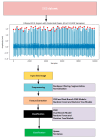AI-Driven Detection of Obstructive Sleep Apnea Using Dual-Branch CNN and Machine Learning Models
- PMID: 40426919
- PMCID: PMC12108708
- DOI: 10.3390/biomedicines13051090
AI-Driven Detection of Obstructive Sleep Apnea Using Dual-Branch CNN and Machine Learning Models
Abstract
Background/Objectives: The purpose of this research is to compare and contrast the application of machine learning and deep learning methodologies such as a dual-branch convolutional neural network (CNN) model for detecting obstructive sleep apnea (OSA) from electrocardiogram (ECG) data. Methods: This approach solves the limitations of conventional polysomnography (PSG) and presents a non-invasive method for detecting OSA in its early stages with the help of AI. Results: The research shows that both CNN and dual-branch CNN models can identify OSA from ECG signals. The CNN model achieves validation and test accuracy of about 93% and 94%, respectively, whereas the dual-branch CNN model achieves 93% validation and 94% test accuracy. Furthermore, the dual-branch CNN obtains a ROC AUC score of 0.99, meaning that it is better at distinguishing between apnea and non-apnea cases. Conclusions: The results show that CNN models, especially the dual-branch CNN, are effective in apnea classification and better than traditional methods. In addition, our proposed model has the potential to be used as a reliable, non-invasive method for accurate OSA detection that is even better than the current state-of-the-art advanced methods.
Keywords: ECG; deep learning; dual-branch CNN; machine learning; obstructive sleep apnea (OSA).
Conflict of interest statement
All authors confirm that they have no affiliations with or involvement in any organization or entity with any financial interest (such as honoraria; educational grants; participation in speakers’ bureaus; membership, employment, consultancies, stock ownership, or other equity interest; and expert testimony or patent-licensing arrangements) or non-financial interest (such as personal or professional relationships, affiliations, knowledge or beliefs) in the subject matter or materials discussed in this manuscript.
Figures
















References
-
- Gerstenblith G. Coronary Heart Disease 2007: Johns Hopkins White Papers. Johns Hopkins Health; Baltimore, MD, USA: 2007.
-
- Culebras A., Stephen D., John S.F., Carl E.H., Lyle J.O., Thomas G.P., Richard R., Mary W., Terry Y. Sleep apnea and cardiovascular disease. J. Am. Coll. Cardiol. 2008;52:686–717. - PubMed
-
- Pires G.N., Arnardóttir E.S., Islind A.S., Leppänen T., McNicholas W.T. Consumer sleep technology for the screening of obstructive sleep apnea and snoring: Current status and a protocol for a systematic review and meta-analysis of diagnostic test accuracy. J. Sleep Res. 2023;32:e13819. doi: 10.1111/jsr.13819. - DOI - PubMed
-
- Sharma M., Bapodara S., Tiwari J., Acharya U.R. Automated sleep apnea detection in pregnant women using wavelet-based features. Inform. Med. Unlocked. 2022;32:101026. doi: 10.1016/j.imu.2022.101026. - DOI
LinkOut - more resources
Full Text Sources

